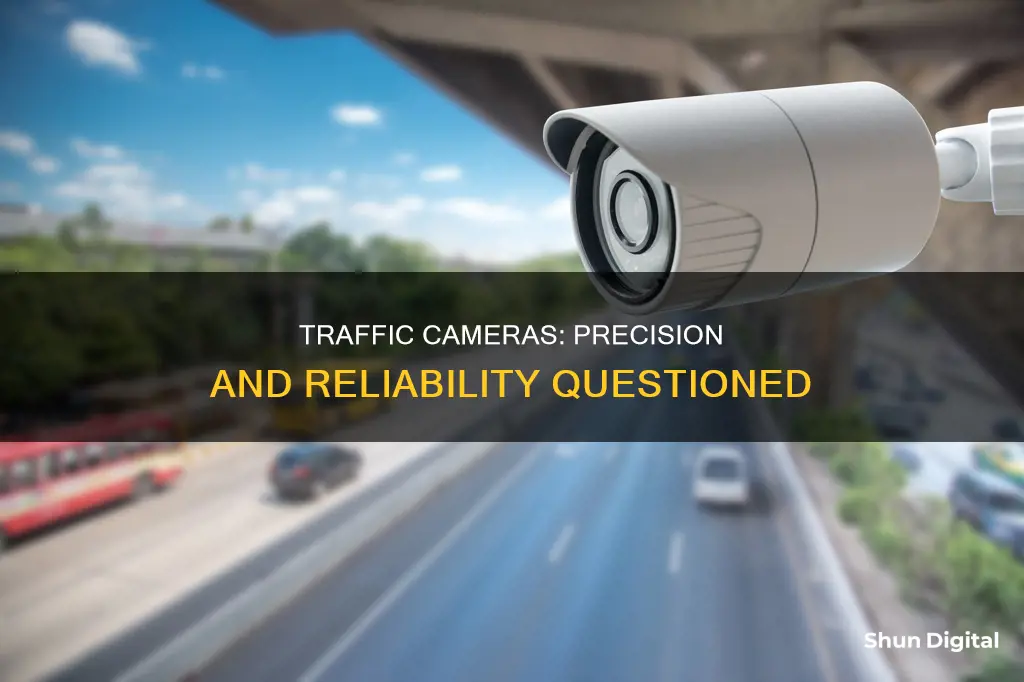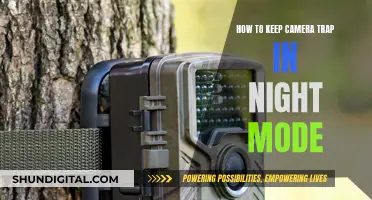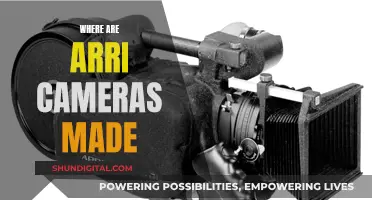
Traffic cameras are an increasingly common feature of roads and highways, and they are used to detect and prosecute motoring offences such as speeding, running red lights, or driving without insurance. But how accurate are they? While some experts say that the technology behind red-light cameras is very solid, there are numerous examples of traffic cameras giving out erroneous fines. In Chicago, for instance, the camera program improperly issued over $2.4 million in fines from 2013 to 2015, and over half of the cameras in use were found to be giving out faulty speeding tickets. Inaccurate cameras are a windfall for local governments, but they can cause serious problems for drivers.
| Characteristics | Values |
|---|---|
| Official accuracy | Calibrated to an accuracy of two per cent |
| Real accuracy | Errors in calibration or usage |
| Camera type | Fixed, mobile, red-light, automatic number-plate recognition |
| Camera function | Detect speeding, red-light running, toll booth non-payment, unauthorised use of bus lanes, congestion charging |
| Camera impact | 11% to 44% reduction in fatal and serious crashes |
| Camera revenue | $15 million per year in Chicago |
What You'll Learn
- Speed cameras can be inaccurate due to calibration errors or usage errors
- Traffic cameras are used for more than just catching speeders
- Cameras can be placed in fixed or mobile positions
- Red-light cameras are triggered when a vehicle enters an intersection above a preset minimum speed
- The use of traffic cameras is controversial, with some arguing they are a form of Big Brother surveillance

Speed cameras can be inaccurate due to calibration errors or usage errors
Speed cameras are designed to catch speeders and other offenders, such as those driving stolen or uninsured cars. While they are officially described as being calibrated to an accuracy of two per cent, there have been several well-publicised court cases that have hinged on the alleged inaccuracies of speed camera evidence.
Usage errors can occur when speed cameras are used in areas with high traffic volume, such as in London, where a higher tolerance for speeding is allowed. Different car speedometers can also display varying speeds, with some showing a higher speed than what the car is actually travelling.
Traffic Camera Tickets: Are They Legal in Texas?
You may want to see also

Traffic cameras are used for more than just catching speeders
In the UK, traffic cameras are also used to detect untaxed and uninsured vehicles, stolen cars, and for potential mass surveillance of motorists.
The use of traffic cameras has been shown to reduce accidents and injuries. A worldwide review of studies found that speed cameras led to an 11% to 44% reduction in fatal and serious injury crashes. The British Medical Journal reported that speed cameras were effective and recommended wider deployment. An LSE study in 2017 found that adding 1,000 cameras to British roads could save up to 190 lives per year.
While traffic cameras are an effective tool for reducing accidents and improving road safety, there are concerns about their accuracy and potential for misuse. Some see them as a revenue-generating tool for local authorities rather than a safety measure. There have been cases where motorists have successfully challenged the accuracy of speed camera evidence in court.
To ensure the effectiveness and legitimacy of traffic cameras, it is essential to have proper calibration, usage, and oversight. This includes providing drivers with the right to review the operator's statement, calibration certificates, and other relevant documentation.
Who's Mapping Our World? Camera Cars and Their Companies
You may want to see also

Cameras can be placed in fixed or mobile positions
Mobile cameras, on the other hand, are often installed in stationary police vehicles and employ laser technology to detect vehicle speed. They are said to be accurate at distances of up to a kilometre, utilising the Doppler effect to measure speed. The mobility of these cameras allows for flexibility in placement and the ability to monitor multiple locations.
The choice between fixed and mobile cameras depends on the specific requirements of the surveillance operation. Fixed cameras offer stability and a wider field of view, while mobile cameras provide accuracy in speed detection and the advantage of being easily moved to different locations.
In terms of accuracy, speed cameras are officially described as being calibrated to an accuracy of two per cent. However, there have been legal cases that have questioned the reliability of the evidence provided by these cameras. Any inaccuracies in mobile cameras are often a result of errors in calibration or usage, and drivers challenging a prosecution are entitled to see the operator's statement and calibration certificate.
Setting Up a Computer Camera: A Step-by-Step Guide
You may want to see also

Red-light cameras are triggered when a vehicle enters an intersection above a preset minimum speed
Red-light cameras are an important tool for enforcing traffic laws and improving road safety. They are designed to capture photographic evidence of vehicles that enter an intersection after the traffic signal has turned red. These cameras are triggered by sensors installed in the road, which detect when a vehicle passes over the stop line or the induction loops.
The functioning of red-light cameras can be understood through their interaction with these sensors. In most systems, there are two loop triggers for each lane of traffic. When a vehicle moves over these loops at a certain speed, the sensors are activated, triggering the camera. The system is programmed to differentiate between vehicles moving at different speeds. If both triggers are activated in quick succession, the system recognises that a car has entered the intersection at a high speed. On the other hand, if there is a delay between the activations, the system interprets it as a vehicle moving more slowly or coming to a stop.
To capture the violation, the camera takes two photographs. The first shot is taken when the vehicle enters the intersection, and the second one is taken a moment later, showing the car in the middle of the intersection. The computer calculates the delay between the shots based on the measured speed of the vehicle. The camera also superimposes additional information on the photos, including the intersection location, the vehicle's speed, and the time elapsed since the light turned red.
The photographic evidence is then reviewed by law enforcement officials, who determine whether a violation has occurred. The owner of the vehicle is then issued a citation or a fine. The presence of red-light cameras acts as a deterrent against traffic violations and helps authorities identify and penalise offenders, contributing to safer roads.
While red-light cameras are an effective tool, there are some considerations regarding their accuracy. The sensors and cameras must be properly calibrated to ensure reliable measurements. Additionally, factors such as the length of yellow lights and the definition of a violation can impact the accuracy of the system. For example, some jurisdictions allow for a grace period of a few seconds before considering a driver in violation of the red light.
Preventing External Camera Crashes: A Guide for Computers
You may want to see also

The use of traffic cameras is controversial, with some arguing they are a form of Big Brother surveillance
The use of traffic cameras is a highly debated topic, with some people arguing that they are a necessary tool for enforcing traffic laws and improving road safety, while others view them as an invasion of privacy and a form of Big Brother surveillance.
Traffic cameras, including red-light and speed cameras, have been adopted in many cities and states as a means to enforce traffic laws and reduce collisions. Supporters of traffic cameras argue that they are an effective tool for reducing speeding and red-light violations, which can lead to a significant decrease in vehicle-related deaths and serious injuries. For instance, studies have shown that red-light cameras can reduce fatal crashes due to red-light violations by up to 24%. Additionally, speed cameras are considered to be reliable, with a reported accuracy of two percent, and their use can free up police resources, allowing them to focus on more serious crimes.
However, there is also a strong backlash against the use of traffic cameras, with some arguing that they infringe on civil liberties and privacy rights. Critics claim that traffic cameras shift the burden of proof to drivers, who must then prove their innocence. The large sums of money generated from fines have also caused controversy, with opponents arguing that the cameras are merely a way for local governments and camera manufacturers to generate revenue. In some cases, contracts between local governments and camera companies include revenue-sharing agreements, creating an incentive to issue more tickets. This has led to concerns about the potential for abuse and the prioritization of profit over public safety.
Additionally, there have been concerns about the accuracy and reliability of traffic cameras. While they are generally considered accurate, there have been instances of mechanical failures and erroneous tickets. Drivers have the right to challenge their tickets and request evidence, such as the operator's statement and calibration certificate, which has led to successful appeals in some cases.
The debate surrounding the use of traffic cameras is complex and multifaceted. While they can provide benefits in terms of road safety and traffic law enforcement, there are also valid concerns about privacy, fairness, and the potential for abuse. As a result, communities and lawmakers are faced with the challenging task of balancing these factors when deciding whether to implement or expand the use of traffic cameras.
Where's the Power? 35mm Cameras and Their Battery Usage
You may want to see also
Frequently asked questions
Traffic cameras are typically mounted beside or over a road or installed in enforcement vehicles. They detect motoring offenses, including speeding, red-light running, toll booth evasion, and unauthorized use of bus lanes. The cameras may be linked to an automated ticketing system.
While traffic cameras are generally considered reliable, there have been instances of inaccuracies and errors. In Chicago, for example, the camera program issued over $2.4 million in erroneous fines from 2013 to 2015 due to improper speed limit signage or faulty cameras.
The accuracy of traffic cameras can be influenced by various factors, including calibration and usage errors, faulty yellow light timing, and environmental conditions such as cold weather or tectonic shifts that can affect pavement integrity.
Inaccurate traffic cameras can result in erroneous fines and citations for drivers, impacting their records and finances. It also raises concerns about the legitimacy of safety efforts and the potential for revenue generation by local authorities.
To enhance the accuracy of traffic cameras, regular calibration and maintenance are essential. Additionally, proper signage and speed limit indicators should be in place to ensure drivers are aware of the speed limits.







